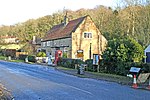St Martin's Ampleforth
1930 establishments in England2020 disestablishments in EnglandBoarding schools in North YorkshireCatholic boarding schools in EnglandDefunct Catholic schools in the Diocese of Middlesbrough ... and 5 more
Defunct schools in North YorkshireEducational institutions disestablished in 2020Educational institutions established in 1930Schools of the English Benedictine CongregationUse British English from June 2018
St Martin's Ampleforth (SMA) was a private school and the preparatory school for Ampleforth College, which closed in July 2020. Until 2018 it was at Gilling Castle, North Yorkshire, England, on the southern side of a valley opposite the College on the northern side, in the Roman Catholic Diocese of Middlesbrough.
Excerpt from the Wikipedia article St Martin's Ampleforth (License: CC BY-SA 3.0, Authors).St Martin's Ampleforth
North Walk,
Geographical coordinates (GPS) Address Nearby Places Show on map
Geographical coordinates (GPS)
| Latitude | Longitude |
|---|---|
| N 54.183273 ° | E -1.064923 ° |
Address
North Walk
YO62 4HP
England, United Kingdom
Open on Google Maps










